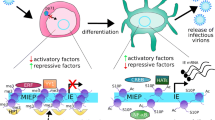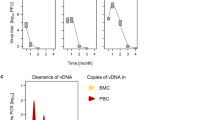Abstract
The promise of the mouse model of cytomegalovirus (CMV) research lies in a cost effective way to obtain significant data in in vivo settings. Keeping that promise requires a high degree of equivalency in the human and mouse virus. While genomic structure and many common proteins suggest that this system is appropriate to develop and test concepts in an organismal context, areas of difference have not been evaluated. Here we show that the major immediate early protein 1 (IE1) in MCMV binds the repressor Daxx suggesting that it serves a function performed by pp71 in HCMV. A Daxx binding pp71 equivalent at M82 could not be identified for MCMV. Differences in the mouse and human interferon upregulation of Daxx may have driven the need to have a Daxx-defeating function during reactivation, when pp71 is not present. The major immediate early protein 1 also differs in its chromatin binding properties between the two viruses. MCMV IE1 does not bind to chromatin, but HCMV IE1 does. It remains unclear whether this difference is functionally significant. The HCMV major immediate early protein 2 and its MCMV equivalent IE3 differ in their effect on the cell cycle; HCMV IE2 blocks the cell cycle, but MCMV IE3 does not, allowing MCMV to spread in infected mouse cells by cell division with continued expression of the major transactivating viral proteins. Actively transcribing genomes inducing immediate transcript environments are usually silenced and diminish during cell cycle progression. However, a recognizable desilencing and increase in immediate transcript environments takes place immediately after mitosis in MCMV infected cells. This raises the possibility that desilencing happens during tissue transplantation, wound healing, or other injury where cells are induced to proliferate.





Similar content being viewed by others
References
Sanchez V, Spector DH (2006) Exploytation of host cell cycle regulatory pathways by HCMV. In: Reddehase MJ (ed) Cytomegaloviruses. Caister Academic Press, Norfolk, pp 205–230
Tang Q, Maul GG (2006) Immediate-early interactions and epigenetic defense mechanisms. In: Reddehase MJ (ed) Cytomegaloviruses. Caister Academic Press, Norfolk, pp 131–150
Ishov AM, Sotnikov AG, Negorev D, Vladimirova OV, Neff N, Kamitani T, Yeh ET, Strauss JF III, Maul GG (1999) PML is critical for ND10 formation and recruits the PML-interacting protein Daxx to this nuclear structure when modified by SUMO-1. J Cell Biol 147:221–234
Ishov AM, Maul GG (1996) The periphery of nuclear domain 10 (ND10) as site of DNA virus deposition. J Cell Biol 134:815–826
Ishov AM, Stenberg RM, Maul GG (1997) Human cytomegalovirus immediate early interaction with host nuclear structures: definition of an immediate transcript environment. J Cell Biol 138:5–16
Kapasi AJ, Spector DH (2008) Inhibition of the cyclin-dependent kinases at the beginning of human cytomegalovirus infection specifically alters the levels and localization of the RNA polymerase II carboxyl-terminal domain kinases cdk9 and cdk7 at the viral transcriptosome. J Virol 82:394–407
Tang Q, Maul GG (2003) Mouse cytomegalovirus immediate-early protein 1 binds with host cell repressors to relieve suppressive effects on viral transcription and replication during lytic infection. J Virol 77:1357–1367
Saffert RT, Kalejta RF (2006) Inactivating a cellular intrinsic immune defense mediated by Daxx is the mechanism through which the human cytomegalovirus pp71 protein stimulates viral immediate-early gene expression. J Virol 80:3863–3871
Tavalai N, Papior P, Rechter S, Leis M, Stamminger T (2006) Evidence for a role of the cellular ND10 protein PML in mediating intrinsic immunity against human cytomegalovirus infections. J Virol 80:8006–8018
Lin DY, Huang YS, Jeng JC, Kuo HY, Chang CC, Chao TT, Ho CC, Chen YC, Lin TP, Fang HI et al (2006) Role of SUMO-interacting motif in Daxx SUMO modification, subnuclear localization, and repression of sumoylated transcription factors. Mol Cell 24:341–354
Saffert RT, Kalejta RF (2007) Human cytomegalovirus gene expression is silenced by Daxx-mediated intrinsic immune defense in model latent infections established in vitro. J Virol 81:9109–9120
Cranmer LD, Clark CL, Morello CS, Farrell HE, Rawlinson WD, Spector DH (1996) Identification, analysis, and evolutionary relationships of the putative murine cytomegalovirus homologs of the human cytomegalovirus UL82 (pp71) and UL83 (pp65) matrix phosphoproteins. J Virol 70:7929–7939
Tang Q, Maul GG (2006) Mouse cytomegalovirus crosses the species barrier with help from a few human cytomegalovirus proteins. J Virol 80:7510–7521
Hollenbach AD, Sublett JE, McPherson CJ, Grosveld G (1999) The Pax3-FKHR oncoprotein is unresponsive to the Pax3-associated repressor hDaxx. Embo J 18:3702–3711
Xu Y, Ahn JH, Cheng M, apRhys CM, Chiou CJ, Zong J, Matunis MJ, Hayward GS (2001) Proteasome-independent disruption of PML oncogenic domains (PODs), but not covalent modification by SUMO-1, is required for human cytomegalovirus immediate-early protein IE1 to inhibit PML-mediated transcriptional repression. J Virol 75:10683–10695
Johnson ES (2004) Protein modification by sumo. Annu Rev Biochem 73:355–382
Nevels M, Brune W, Shenk T (2004) SUMOylation of the human cytomegalovirus 72-kilodalton IE1 protein facilitates expression of the 86-kilodalton IE2 protein and promotes viral replication. J Virol 78:7803–7812
Lee HR, Kim DJ, Lee JM, Choi CY, Ahn BY, Hayward GS, Ahn JH (2004) Ability of the human cytomegalovirus IE1 protein to modulate sumoylation of PML correlates with its functional activities in transcriptional regulation and infectivity in cultured fibroblast cells. J Virol 78:6527–6542
Tavalai N, Papior P, Rechter S, Stamminger T (2008) Nuclear domain 10 components promyelocytic leukemia protein and hDaxx independently contribute to an intrinsic antiviral defense against human cytomegalovirus infection. J Virol 82:126–137
Ahn JH, Brignole EJ 3rd, Hayward GS (1998) Disruption of PML subnuclear domains by the acidic IE1 protein of human cytomegalovirus is mediated through interaction with PML and may modulate a RING finger-dependent cryptic transactivator function of PML. Mol Cell Biol 18:4899–4913
Angulo A, Ghazal P, Messerle M (2000) The major immediate-early gene ie3 of mouse cytomegalovirus is essential for viral growth. J Virol 74:11129–11136
White EA, Clark CL, Sanchez V, Spector DH (2004) Small internal deletions in the human cytomegalovirus IE2 gene result in nonviable recombinant viruses with differential defects in viral gene expression. J Virol 78:1817–1830
Caswell R, Hagemeier C, Chiou CJ, Hayward G, Kouzarides T, Sinclair J (1993) The human cytomegalovirus 86 K immediate early (IE) 2 protein requires the basic region of the TATA-box binding protein (TBP) for binding, and interacts with TBP and transcription factor TFIIB via regions of IE2 required for transcriptional regulation. J Gen Virol 74(Pt 12):2691–2698
Hagemeier C, Walker S, Caswell R, Kouzarides T, Sinclair J (1992) The human cytomegalovirus 80-kilodalton but not the 72-kilodalton immediate-early protein transactivates heterologous promoters in a TATA box-dependent mechanism and interacts directly with TFIID. J Virol 66:4452–4456
Lukac DM, Harel NY, Tanese N, Alwine JC (1997) TAF-like functions of human cytomegalovirus immediate-early proteins. J Virol 71:7227–7239
Malone CL, Vesole DH, Stinski MF (1990) Transactivation of a human cytomegalovirus early promoter by gene products from the immediate-early gene IE2 and augmentation by IE1: mutational analysis of the viral proteins. J Virol 64:1498–1506
Messerle M, Buhler B, Keil GM, Koszinowski UH (1992) Structural organization, expression, and functional characterization of the murine cytomegalovirus immediate-early gene 3. J Virol 66:27–36
Buhler B, Keil GM, Weiland F, Koszinowski UH (1990) Characterization of the murine cytomegalovirus early transcription unit e1 that is induced by immediate-early proteins. J Virol 64:1907–1919
Ahn JH, Jang WJ, Hayward GS (1999) The human cytomegalovirus IE2 and UL112–113 proteins accumulate in viral DNA replication compartments that initiate from the periphery of promyelocytic leukemia protein-associated nuclear bodies (PODs or ND10). J Virol 73:10458–10471
Petrik DT, Schmitt KP, Stinski MF (2007) The autoregulatory and transactivating functions of the human cytomegalovirus IE86 protein use independent mechanisms for promoter binding. J Virol 81:5807–5818
Iwayama S, Yamamoto T, Furuya T, Kobayashi R, Ikuta K, Hirai K (1994) Intracellular localization and DNA-binding activity of a class of viral early phosphoproteins in human fibroblasts infected with human cytomegalovirus (Towne strain). J Gen Virol 75(Pt 12):3309–3318
Tang Q, Li L, Maul GG (2005) Mouse cytomegalovirus early M112/113 proteins control the repressive effect of IE3 on the major immediate-early promoter. J Virol 79:257–263
Sourvinos G, Tavalai N, Berndt A, Spandidos DA, Stamminger T (2007) Recruitment of human cytomegalovirus immediate-early 2 protein onto parental viral genomes in association with ND10 in live-infected cells. J Virol 81:10123–10136
Wiebusch L, Hagemeier C (1999) Human cytomegalovirus 86-kilodalton IE2 protein blocks cell cycle progression in G(1). J Virol 73:9274–9283
Murphy EA, Streblow DN, Nelson JA, Stinski MF (2000) The human cytomegalovirus IE86 protein can block cell cycle progression after inducing transition into the S phase of permissive cells. J Virol 74:7108–7118
Kurz SK, Reddehase MJ (1999) Patchwork pattern of transcriptional reactivation in the lungs indicates sequential checkpoints in the transition from murine cytomegalovirus latency to recurrence. J Virol 73:8612–8622
Reddehase MJ, Podlech J, Grzimek NK (2002) Mouse models of cytomegalovirus latency: overview. J Clin Virol 25(Suppl 2):S23–36
Acknowledgments
The MCMV GFP IE1/3 and the MCMV GFP IE3 virus has been generated by Qiyi Tang and their characterization is in progress (Tang QY and Maul GG in preparation). Olga Vladimirova has performed most of the other unpublished experiments. Both their help is very much appreciated.
Author information
Authors and Affiliations
Corresponding author
Rights and permissions
About this article
Cite this article
Maul, G.G., Negorev, D. Differences between mouse and human cytomegalovirus interactions with their respective hosts at immediate early times of the replication cycle. Med Microbiol Immunol 197, 241–249 (2008). https://doi.org/10.1007/s00430-008-0078-1
Received:
Published:
Issue Date:
DOI: https://doi.org/10.1007/s00430-008-0078-1




